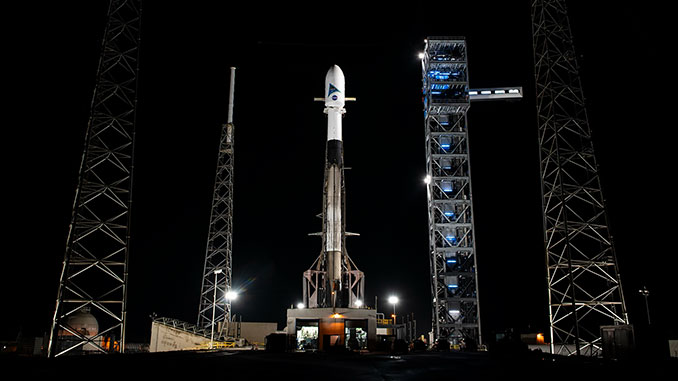
Update 9:55 p.m. EST: SpaceX and NASA scrubbed the launch due to poor weather.
SpaceX is preparing to launch its second NASA mission of the year on Wednesday morning. A Falcon 9 rocket carrying the Earth-observing spacecraft PACE (Plankton, Aerosol, Cloud, ocean Ecosystem) was set to liftoff Tuesday morning, but teams had to stand down due to poor weather.
Teams from NASA, SpaceX and Space Launch Delta 45 (SLD45) are now aiming for the 24-hour backup opportunity: a 1:33 a.m. EST (0633 UTC) liftoff from Space Launch Complex 40 (SLC-40) at Cape Canaveral Space Force Station on Feb. 7.
This will be the eighth launch from Florida in 2024 and the seventh for SpaceX from the Space Coast this year. Spaceflight Now will have live coverage of the mission beginning at 11:30 p.m. EST (0430 UTC).
The PACE launch will be the first time a U.S. government mission has targeted a polar orbit from Cape Canaveral in more than 60 years. Polar flights were suspended after a cow in Cuba was killed by falling debris from a failed launch in 1960, sparking protests in Havana.
“At that point, we as a government decided, let’s just take all our polar launch missions to the West and we’ve successfully launched into the polar orbit hundreds of times since the 60s from Vandenberg Space Force Base in California,” said Tim Dunn, the senior launch director for NASA’s Launch Services Program.
SpaceX resumed launches from the Cape on southerly trajectories in 2020. The company has successfully flown 11 missions into polar orbit from the Florida spaceport without incident.
“Along comes SpaceX a handful of years ago with the autonomous flight safety system and the ability to either bring the first stage booster back to land here at the Cape or land on a droneship off-shore,” Dunn said. “And by a combination of those two things, we were able to then do all of the calculations to protect the public, both here in the U.S. as well as our international neighbors in the Caribbean and especially in Cuba and to get the numbers right where we can now successfully do that.”
The Falcon 9 first stage booster supporting this launch, tail number B1081, will be making its fourth flight. It previously launched the Crew-7 quartet to the ISS as well as a Cargo Dragon and a Starlink mission.
Dunn said their consideration for reflights on a booster has less to do with the basic number as much as it has to do with what kinds of missions it has flown to date.
“We don’t look at the number of particular flights of a booster. We look at the qualification status of all the components that go into that booster,” Dunn explained. “We do an evaluation and as long as we do not exceed [qualification] status, and some components do get replaced in between flights, and then we do analysis on some of the structures that are not replaced, we’re comfortable.”
NASA’s Europa Clipper will be the first time the agency will rely upon boosters that have flown five previous missions. Those Falcon Heavy side boosters most recently supported the launch of NASA’s Psyche spacecraft.
Following stage separation, the booster will flip to return for a landing at Landing Zone 1 (LZ-1) at the Cape about 7.5 minutes after liftoff. This will be its third LZ-1 landing out of four flights.
This landing will mark the 36th for LZ-1 and the 45th in Florida. Assuming SpaceX doesn’t squeeze in a Starlink launch from VSFB on Monday night and that the PACE mission is successful, this will be the company’s 270th booster landing to date.
The total cost of the mission, between building the spacecraft, the launch operations and the mission support once on orbit, is $948 million, according to Dunn. For the launch services of the Falcon 9 rocket, NASA paid SpaceX about $81 million.
Dunn said they are using new payload fairings on this flight, but are evaluating that possibility for the future.
“We are under evaluation with SpaceX right now and I would anticipate that to happen in the next year-and-a-half or two,” Dunn said. “We’ll see how that goes for the fairing.”
Weather concerns for atmosphere observing mission
As the launch teams were heading towards the launch window overnight, weather remained a watch item. During a prelaunch briefing with press, Brian Cizek, a launch weather officer with the 45th Weather Squadron for the U.S. Space Force, said the probability of violating weather was 60 percent for the Tuesday morning launch opportunity.
“We’re going to see this wind surge kind of come down the Florida coast from north to south. That’s also going to bring some additional moisture into the air,” Cizek said. “So, a few concerns with the launch tonight due to that.”
Cizek said the liftoff winds would be “getting close to the limits” around launch time with the winds “increasing as the night progresses.” He said those winds will decrease by Tuesday night, which is partly why the launch forecast improves to only 40 percent chance of violating weather on Wednesday morning.
He also said forecasters with SLD45 also have concerns about showers along the coastline creating a violation of the cumulus cloud rule. The corresponding clouds also bring the thick cloud layers rule into play for this first launch opportunity as well.
“The thing for the backup day, the major concern will again be the liftoff winds. We said they kind of peak during the morning and early afternoon on Tuesday and then when they do begin to decrease again as we head into Tuesday evening,” Cizek said. “And then the weather just continues to improve as we get beyond that.”
Expanding ocean and atmosphere understanding
The PACE mission is designed to last three years nominally, but carries enough fuel to support a 10-year mission. NASA will reevaluate things about every three years to determine if they are able to and desire to extend the mission.
The goal of the Earth-observing spacecraft will be to increase our understanding of the interplay of the oceans and the atmosphere through the lens of some of the tiniest parts of each: phytoplankton and aerosols.
“These micro-algae that are at the base of the marine food chain, they serve our fisheries and serve the health of the oceans, but they can also be toxic and we need to know that too,” said Karen St. Germain, the director of NASA’s Earth Science Division. “They’re also responsible, through photosynthesis, for absorbing a tremendous amount of carbon dioxide and converting that into oxygen in the atmosphere.”
“We’re also looking at tiny things in the atmosphere. These are called aerosols. they’re tiny particles that play an enormous role in our weather, our air quality and even our climate,” she added. “They come from sources like dust flowing off the Sahara, wildfires and even human activities. They seed clouds that can grow into hurricanes coming across the Atlantic, but they also reflect a lot of the Sun’s energy. So, they play an important role in the long-term stability of Earth’s climate.”
St. Germain said the mission builds on both 20 years of NASA’s work observing the oceans and more than 60 years of overall NASA Earth observation. She noted that understanding these systems and their interplay is not only important for advancing scientific understanding, but it also has a big role for the U.S. economy.
“The ocean economy makes up over $350 billion of our gross domestic product per year. It employs 3.1 million people in our country, but it can also experience adverse impacts from things like harmful algal blooms, which can cost $50 million a year or more,” St. Germain said. “So, the work we’re doing with PACE and the work we do in Earth Science is about making observations to help us understand the Earth System, capturing that understanding in models and predictive tools and putting that information into the hands of people who can use it to make better decisions every day.”


 Crypto Front News
Crypto Front News DogeHome
DogeHome Optimisus
Optimisus BlockchainReporter
BlockchainReporter CryptoPotato_News
CryptoPotato_News






















